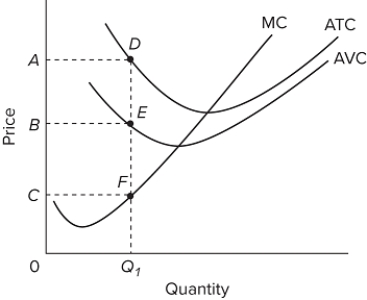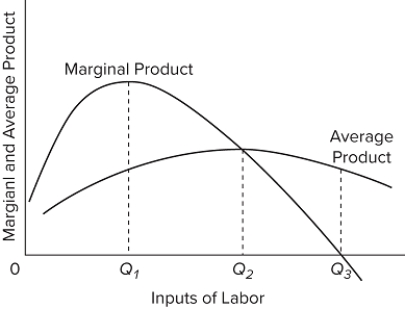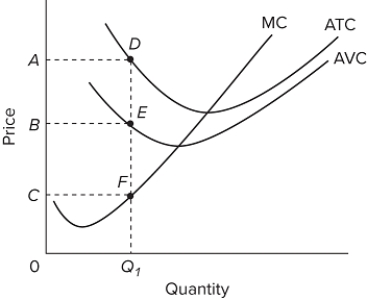A) $120,000.
B) $600,000.
C) $49,000.
D) $720,000.
Correct Answer

verified
Correct Answer
verified
Multiple Choice
 Refer to the provided graph. If the firm is producing at Q ₁, the area 0 ADQ ₁ represents
Refer to the provided graph. If the firm is producing at Q ₁, the area 0 ADQ ₁ represents
A) total costs.
B) total variable costs.
C) total fixed costs.
D) average total costs.
Correct Answer

verified
Correct Answer
verified
Multiple Choice
If all resources used in the production of a product are increased by 10 percent and output increases by less than 5 percent, then the firm is experiencing
A) economies of scale.
B) diseconomies of scale.
C) constant returns to scale.
D) decreasing average total costs.
Correct Answer

verified
Correct Answer
verified
Multiple Choice
Which statement is correct?
A) Marginal cost is the change in average cost when there is a change in output of 1 unit.
B) The marginal cost curve cuts the average variable cost curve at its lowest point.
C) The marginal cost curve cuts the average variable cost curve at an output greater than where the marginal cost curve cuts the average cost curve.
D) If average variable cost is increasing, then average total cost must be increasing too.
Correct Answer

verified
Correct Answer
verified
Multiple Choice
The following cost data are for a firm in the short run.  What is the firm's average variable cost at an output of 5 units?
What is the firm's average variable cost at an output of 5 units?
A) $30
B) $60
C) $120
D) $140
Correct Answer

verified
Correct Answer
verified
Multiple Choice
Because of higher gasoline prices, firms using gasoline intensively in the production or distribution of their goods have experienced
A) an upward shift in their MC, AVC, and ATC curves.
B) an upward shift in their AFC, AVC, and ATC curves.
C) a downward shift in their MC, AFC, and AVC curves.
D) greater economies of scale.
Correct Answer

verified
Correct Answer
verified
Multiple Choice
The following is cost information for the Creamy Crisp Donut Company.Entrepreneur's potential earnings as a salaried worker = $50,000Annual lease on building = $22,000Annual revenue from operations = $380,000Payments to workers = $120,000Utilities (electricity, water, disposal) costs = $8,000Value of entrepreneur's talent in the next best entrepreneurial activity = $80,000Entrepreneur's forgone interest on personal funds used to finance the business = $6,000Creamy Crisp's implicit costs, including a normal profit, are
A) $136,000.
B) $150,000.
C) $94,000.
D) $156,000.
Correct Answer

verified
Correct Answer
verified
Multiple Choice
Suppose that a business incurred implicit costs of $200,000 and explicit costs of $1 million in a specific year. If the firm sold 4,000 units of its output at $300 per unit, its accounting profits were
A) $100,000 and its economic profits were $0.
B) $200,000 and its economic profits were $0.
C) $100,000 and its economic profits were $100,000.
D) $0 and its economic loss was $200,000.
Correct Answer

verified
Correct Answer
verified
Multiple Choice
Use the following data to answer the question. The letters A, B, and C designate three successively larger plant sizes.  At what level of output is minimum efficient scale realized?
At what level of output is minimum efficient scale realized?
A) 30
B) 40
C) 50
D) 60
Correct Answer

verified
Correct Answer
verified
Multiple Choice
 Refer to the diagram, where variable inputs of labor are being added to a constant amount of property resources. The total output of this firm will cease to expand
Refer to the diagram, where variable inputs of labor are being added to a constant amount of property resources. The total output of this firm will cease to expand
A) if a labor force in excess of Q₁ is employed.
B) if a labor force in excess of Q₂ is employed.
C) if a labor force in excess of Q₃ is employed.
D) only if the marginal product curve becomes negative at all levels of output.
Correct Answer

verified
Correct Answer
verified
True/False
A major factor explaining economies of scale is increased specialization of labor.
Correct Answer

verified
Correct Answer
verified
Multiple Choice
Which of the following constitutes an implicit cost to the Johnston Manufacturing Company?
A) payments of wages to its office workers
B) rent paid for the use of equipment owned by the Schultz Machinery Company
C) use of savings to pay operating expenses instead of generating interest income
D) economic profits resulting from current production
Correct Answer

verified
Correct Answer
verified
Multiple Choice
Answer the question on the basis of the following information.  When two workers are employed,
When two workers are employed,
A) total product is 20.
B) total product is 18.
C) average product is 10.
D) total product cannot be determined from the information given.
Correct Answer

verified
Correct Answer
verified
Multiple Choice
If economic profits in an industry are zero and implicit costs are greater than zero, then
A) resources will move out of the industry.
B) there will be no production in the short run.
C) accounting profits are greater than zero.
D) new firms will enter the industry.
Correct Answer

verified
Correct Answer
verified
Multiple Choice
Which of the following is most likely to be a fixed cost?
A) shipping charges
B) property insurance premiums
C) wages for unskilled labor
D) expenditures for raw materials
Correct Answer

verified
Correct Answer
verified
True/False
When diminishing marginal returns starts occurring, the addition of successive units of a variable resource to a fixed resource will cause the firm's production to diminish.
Correct Answer

verified
Correct Answer
verified
Multiple Choice
Economic profits are
A) always larger than accounting profits.
B) the sum of accounting profits and implicit costs.
C) equal to the difference between total revenues and implicit costs.
D) equal to the difference between accounting profits and implicit costs.
Correct Answer

verified
Correct Answer
verified
Multiple Choice
If in the short run a firm's total product is increasing, then its
A) marginal product must also be increasing.
B) marginal product must be decreasing.
C) marginal product could be either increasing or decreasing.
D) average product must also be increasing.
Correct Answer

verified
Correct Answer
verified
Multiple Choice
Suppose a firm is in a range of production where it is experiencing economies of scale. Knowing this, we can predict that
A) the long-run average total cost curve is upsloping.
B) a 10 percent increase in all inputs will increase output by less than 10 percent.
C) a 10 percent increase in all inputs will increase output by more than 10 percent.
D) the firm is encountering problems of managerial bureaucracy because of its size.
Correct Answer

verified
Correct Answer
verified
Multiple Choice
 Refer to the provided graph. If the firm is producing at Q ₁, the area BADE represents
Refer to the provided graph. If the firm is producing at Q ₁, the area BADE represents
A) total costs.
B) total variable costs.
C) total fixed costs.
D) average variable costs.
Correct Answer

verified
Correct Answer
verified
Showing 181 - 200 of 445
Related Exams